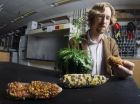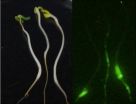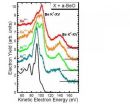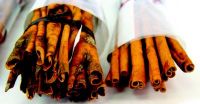(Press-News.org) NASA infrared satellite data from this morning revealed that Tropical Storm Tomas has weakened into a tropical depression.
Tomas is in the central Caribbean Sea headed for Haiti this weekend, and forecasters are calling for a re-intensification before it makes landfall.
The National Hurricane Center (NHC) in Miami, Fla. reported at 5 a.m. EDT on Nov. 3 that hurricane hunter aircraft found an "ill-defined and elongated circulation with no tropical storm-force winds at the flight level or the surface." Thus, the status of Tomas was changed from a tropical storm to a tropical depression.
When NASA's Aqua satellite passed over Tomas on Nov. 3 at 06:17 UTC (2:17 a.m. EDT), the Atmospheric Infrared Sounder (AIRS) instrument onboard captured an infrared image of the cold thunderstorms within the system. The image showed that strong, high thunderstorm cloud tops appeared disorganized and scattered around the depression's center of circulation. The cloud tops have also warmed, indicating that the convection is not as strong as it was the day before.
What a difference 24 hours can make with a tropical cyclone. On the previous day, the Tropical Rainfall Measuring Mission (TRMM) satellite passed over Tomas at 0515 UTC (1:15 a.m. EDT). At that time, TRMM noticed that vertical wind shear (winds that can weaken a tropical cyclone) relaxed allowing Tomas to temporarily re-strengthen a little. At that time, data from TRMM's Microwave Imager (TMI) and Precipitation Radar (PR) revealed that Tomas was producing many strong thunderstorms over a large area of the Caribbean Sea. Since that time, the strength of Tomas' thunderstorms has waned.
Tomas is now a disorganized depression, and is moving at 5 mph toward the west-northwest. Tomas' maximum sustained winds were down to 35 mph. It was centered about 305 miles south-southeast of Kingston, Jamaica and 410 miles southwest of Port Au Prince, Haiti. The NHC estimates that Tomas' center is near 13.7 North and 75.8 West.
The National Hurricane Center's forecast still calls for Tomas to re-intensify into a hurricane before reaching Haiti late Friday, so residents should prepare for its arrival.
INFORMATION:
NASA satellite sees Tomas weaken to a tropical depression ... for now
2010-11-04
ELSE PRESS RELEASES FROM THIS DATE:
Volcanoes have shifted Asian rainfall
2010-11-04
Scientists have long known that large volcanic explosions can affect the weather by spewing particles that block solar energy and cool the air. Some suspect that extended "volcanic winters" from gigantic blowups helped kill off dinosaurs and Neanderthals. In the summer following Indonesia's 1815 Tambora eruption, frost wrecked crops as far off as New England, and the 1991 blowout of the Philippines' Mount Pinatubo lowered average global temperatures by 0.7 degrees F—enough to mask the effects of manmade greenhouse gases for a year or so.
Now, scientists have shown ...
Headgear, mouth guards have little or no impact on reducing concussions in rugby players
2010-11-04
TORONTO, Ont., Nov. 3, 2010 – Existing headgear and mouth guards have limited or no benefit in reducing concussions in rugby players, according to Dr. Michael Cusimano, a neurosurgeon at St. Michael's Hospital.
However, educational injury prevention programs that promote proper playing techniques and enforcement of the rules do result in a significant reduction in concussions and head, neck and spinal injuries, Cusimano concluded after a review of existing studies on the topic.
Cusimano still recommends rugby players wear mouth guards and protective headgear ...
Chromosome imbalances lead to predictable plant defects
2010-11-04
WEST LAFAYETTE, Ind. - Physical defects in plants can be predicted based on chromosome imbalances, a finding that may shed light on how the addition or deletion of genes and the organization of the genome affects organisms, according to a study involving a Purdue University researcher.
The findings identify easily measured characteristics that vary with imbalances of specific chromosomes, said Brian Dilkes, a Purdue assistant professor of horticulture. Understanding why and how those imbalances result in certain characteristics could open the door to correcting those ...
E. coli thrives near plant roots, can contaminate young produce crops
2010-11-04
WEST LAFAYETTE, Ind. - E. coli can live for weeks around the roots of produce plants and transfer to the edible portions, but the threat can be minimized if growers don't harvest too soon, a Purdue University study shows.
Purdue scientists added E. coli to soil through manure application and water treated with manure and showed that the bacteria can survive and are active in the rhizosphere, or the area around the plant roots, of lettuce and radishes. E. coli eventually gets onto the aboveground surfaces of the plants, where it can live for several weeks. Activity in ...
U of M researcher finds public support for HPV vaccine wanes when linked to controversy
2010-11-04
MINNEAPOLIS / ST. PAUL, Minn. (Nov. 2, 2010) – The vaccine that protects against the potentially cancer-causing human papillomavirus (HPV) enjoys wide support in the medical and public health communities. Yet state laws to require young girls to be vaccinated as a requirement for middle school attendance have aroused controversy with parents, politicians, and even medical and public health experts disagreeing about whether such laws are appropriate. News coverage about HPV vaccine requirements tends to amplify this controversy, possibly leading to negative attitudes among ...
Organic onions, carrots and potatoes do not have higher levels of healthful antioxidants
2010-11-04
With the demand for organically produced food increasing, scientists are reporting new evidence that organically grown onions, carrots, and potatoes generally do not have higher levels of healthful antioxidants and related substances than vegetables grown with traditional fertilizers and pesticides. Their study appears in ACS' bi-weekly Journal of Agricultural and Food Chemistry.
In the study, Pia Knuthsen and colleagues point out that there are many reasons to pay a premium for organic food products. The most important reasons for the popularity of organic food products ...
Built-in timer for improving accuracy of cost saving paper-strip medical tests
2010-11-04
Scientists are reporting the development of a simple, built-in timer intended to improve the accuracy of paper tests and test strips for diagnosing diseases inexpensively at-home and elsewhere. Their study appears in ACS' semi-monthly journal Analytical Chemistry.
Scott Phillips and Hyeran Noh note that so-called point-of-care tests include paper strip tests and others performed at home or bedside instead of in laboratories. They show special promise for improving medical care in developing countries and reducing health care costs elsewhere. When fully developed, these ...
Does adolescent stress lead to mood disorders in adulthood?
2010-11-04
Montreal, November 3, 2010 – Stress may be more hazardous to our mental health than previously believed, according to new research from Concordia University. A series of studies from the institution have found there may be a link between the recent rise in depression rates and the increase of daily stress.
"Major depression has become one of the most pressing health issues in both developing and developed countries," says principal researcher Mark Ellenbogen, a professor at the Concordia Centre for Research in Human Development and a Canada Research Chair in Developmental ...
Electrons get confused
2010-11-04
Scientists from Helmholtz-Zentrum Berlin (HZB) observed exotic behaviour from beryllium oxide (BeO) when they bombarded it with high-speed heavy ions: After being shot in this way, the electrons in the BeO appeared "confused", and seemed to completely forget the material properties of their environment. The researchers' measurements show changes in the electronic structure that can be explained by extremely rapid melting around the firing line of the heavy ions. If this interpretation is correct, then this would have to be the fastest melting ever observed. The researchers ...
Levels of coumarin in cassia cinnamon vary greatly even in bark from the same tree
2010-11-04
A "huge" variation exists in the amounts of coumarin in bark samples of cassia cinnamon from trees growing in Indonesia, scientists are reporting in a new study. That natural ingredient in the spice may carry a theoretical risk of causing liver damage in a small number of sensitive people who consume large amounts of cinnamon. The report appears in ACS' bi-weekly Journal of Agricultural and Food Chemistry.
Friederike Woehrlin and colleagues note that cinnamon is the second most popular spice, next to black pepper, in the United States and Europe. Cinnamon, which comes ...






